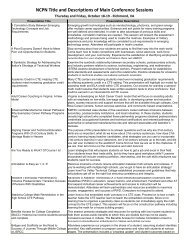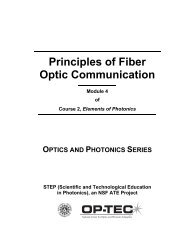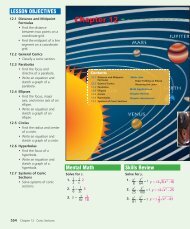hvvrq $ulwkphwlf 6htxhqfhv dqg 6hulhv - NCPN
hvvrq $ulwkphwlf 6htxhqfhv dqg 6hulhv - NCPN
hvvrq $ulwkphwlf 6htxhqfhv dqg 6hulhv - NCPN
Create successful ePaper yourself
Turn your PDF publications into a flip-book with our unique Google optimized e-Paper software.
INSTRUCTION<br />
Provide students with a piece of<br />
graph paper to construct Pascal’s<br />
Triangle.<br />
Point out the symmetry in Pascal’s<br />
Triangle. Show students that if<br />
they were to fold the triangle<br />
along its altitude, that the<br />
numbers would match up.<br />
Tell students that although<br />
Pascal’s Triangle can be traced<br />
back to China in the 12th century,<br />
it was named for the French<br />
Mathematician Blaise Pascal in the<br />
17th century.<br />
<br />
<br />
<br />
<br />
<br />
<br />
<br />
<br />
<br />
<br />
<br />
<br />
<br />
<br />
<br />
<br />
<br />
<br />
<br />
<br />
2. Substitute 3c for a, –4d for b, and 4 for n in the Binomial Theorem:<br />
(3c – 4d) 4 = 4<br />
C 0<br />
(3c) 4 + 4<br />
C 1<br />
(3c) 3 (–4d) + 4<br />
C 2<br />
(3c) 2 (–4d) 2 + 4<br />
C 3<br />
(3c)(–4d) 3 +<br />
4 C 4 (–4d)4 = 81c 4 – 432c 3 d + 864c 2 d 2 – 768cd 3 + 256d 4 .<br />
3. Substitute 2p for a, 5q for b, and 6 for n in the general form of the 3rd<br />
term of the binomial expansion: 6<br />
C 2<br />
(2p) 4 (5q) 2 = 400p 4 q 2 .<br />
4. The expression 6<br />
C 3<br />
means “6 items chosen 3 at a time.”; it is evaluated<br />
as<br />
6!<br />
.<br />
3!( 6−<br />
3)!<br />
5. Multiply n by each of the positive integers less than it until you reach the<br />
integer 1.<br />
Think and Discuss<br />
Answers<br />
1. The coefficients of the terms<br />
of the expansion are the<br />
entries of a row of Pascal’s<br />
Triangle.<br />
9.5 The Binomial Theorem 417











